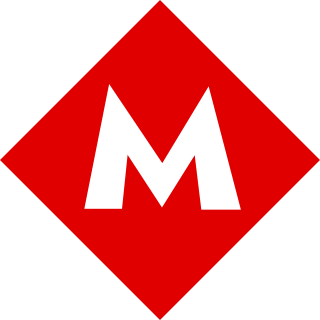
The Ankara Metro is the rapid transit system serving Ankara, the capital of Turkey. At present, Ankara's rapid transit system consists of two metro lines – the Batıkent Metrosu (M1) and the new Keçiören Metrosu (M4) line opened in 2017, along with the Ankaray line. The Ankaray, the M1 and M4 lines, together transported 104.1 million passengers in 2014. That corresponds to a ridership of approximately 289,155 per day. In February 2019 all the lines that used to run M1, M2 and M3 were merged to create one line, M1.

Public transport in Istanbul comprises a bus network, various rail systems, funiculars, and maritime services to serve the more than 15 million inhabitants of the city spread over an area of 5,712 km2.

Gönen is a municipality and district of Balıkesir Province, Turkey. Its area is 1,162 km2, and its population is 74,871 (2022). It lies on the southern part of Marmara Sea. The town is mostly known for its therapeutic hot springs, leather processing and rice production.
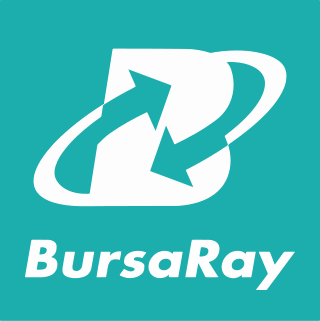
Bursaray is a rapid transit system in the city of Bursa, Marmara Region, Turkey, built in 2000 by TÜVASAŞ, and operated by Burulaş. The name Bursaray is a portmanteau of Bursa, and Ray, the Turkish word for "rail". The Bursaray metro opened for passenger service on 24 April 2002. The metro system presently consists of two lines, which share a main line in the east, and branch into two lines at the western end of the system.

The Istanbul Metro is a rapid transit railway network that serves the city of Istanbul, Turkey. Apart from the M11 line, which is operated by TCDD Taşımacılık, the system is operated by Metro Istanbul, a public enterprise controlled by the Istanbul Metropolitan Municipality. The oldest section of the metro is the M1 line, which opened in 1989. As of March 2024, the system now includes 158 stations in service, with 36 more under construction. Istanbul is the city with the 22nd longest metro line in the world and the 4th in Europe.
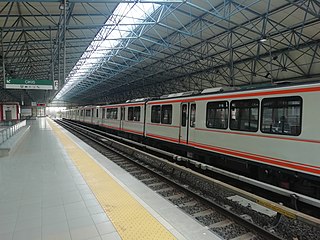
Ankaray, designated as the A1, is a 8.5 km (5.3 mi) long rapid transit line of the Ankara Metro system in Ankara, Turkey. Opened in 1996, it is the oldest rapid transit line in Ankara and the second oldest in Turkey after the M1 line of the Istanbul Metro. Ankaray begins at the Ankara Intercity Bus Terminal in southeastern Yenimahalle and runs east to Dikimevi in northeastern Çankaya and consists of 11 stations. In 2017, the line saw over 33.5 million boardings, making it the second busiest line of Ankara Metro, after the M1. Despite being a rapid transit line, the city of Ankara classifies Ankaray as a light-rail line.

Turkey has a state-owned railway system built to standard gauge which falls under the remit of the Ministry of Transportation and Infrastructure. The primary rail carrier is the Türkiye Cumhuriyeti Devlet Demiryolları (TCDD) which is responsible for all long-distance and cross-border freight and passenger trains. A number of other companies operate suburban passenger trains in urban conurbations.
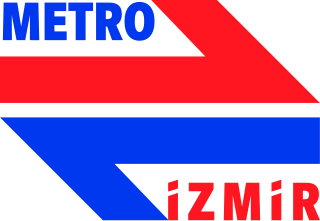
The İzmir Metro is a light metro system serving the city of İzmir, Turkey. The current system, consisting of one line, starts from Kaymakamlık station in the southwestern portion of the metropolitan area and runs towards northeast to end at Evka-3 in Bornova. İzmir's metro line is 27-kilometre (17 mi) long, and serves 24 stations as of 4 March 2024.

The State Railways of the Republic of Turkey, abbreviated as TCDD, is a government-owned national railway company responsible with the ownership and maintenance of railway infrastructure in Turkey, as well as the planning and construction of new lines. TCDD was formed on 4 June 1929 as part of the nationalisation of railways in Turkey.

Adana Metro is a rail rapid transit system extending 13.5 kilometers (8.39 mi) along a north–south corridor through Adana, with 13 stations. It can transport 21,600 passengers per hour per direction. The total travel time on the metro, end to end, takes 21 minutes, including all stops.

The M1, also known as the Kaymakamlık–Evka 3 Line, is the only active line of the İzmir Metro in İzmir, Turkey. The 27 kilometres (17 mi) line runs from Kaymakamlık station in the west to Evka 3 station in the east, consisting of 24 stations. Construction of the first stage of line began in 1992 and was completed in 2000, consisting of 10 initial stations.

Yüksek Hızlı Tren or YHT is a high-speed rail service in Turkey, operated by TCDD Taşımacılık, and is the railway's premier intercity train service. As of 2022, the network spans 1,385 km (860.6 mi) and services major cities like Istanbul, Ankara, Eskişehir, İzmit, Konya and Sivas. Expansion of the system is underway and the network is expected to reach Edirne, Afyonkarahisar, Adana and İzmir in the 2020s.
İzmir is a transportation hub for western Anatolia. İzmir has an extensive bus system, a developing metro, commuter rail system and a large urban ferry network. The city has highways connecting it to Çeşme, Menemen, Istanbul, Bursa and Aydın as well as a beltway. Mass transportation is operated by four separate public agencies all owned by the İzmir Municipality.
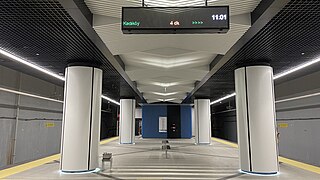
The M4, officially referred to as the M4 Kadıköy - Sabiha Gökçen Airport metro line, is a 33.5-kilometre (20.8 mi), 23-station rapid transit line of the Istanbul Metro. It is colored deep pink on the maps and route signs. Running between Kadıköy and Sabiha Gökçen Airport, it is the first rapid transit line operating on the Asian side of Istanbul. The M4 mostly runs under State road D100, parallel to the Istanbul-Ankara railway and is entirely underground.

The M3, officially referred to as the M3 Bakırköy Sahil–Kayaşehir Merkez Metro Line, is a 26.7-kilometre (16.6 mi), 19-station rapid transit line of the Istanbul Metro system on the European part of Istanbul, Turkey. It operates between Bakırköy Sahil and Kayaşehir Merkez. The M3-line is colored light blue on station signs, route signs and the official rapid transit network map.

TCDD Transport is a government-owned railway company responsible for the operations of most passenger and freight rail in Turkey. The company was formed on 14 June 2016, splitting off from the Turkish State Railways (TCDD) to take over railway operations, while TCDD would continue to administer railway infrastructure. TCDD Taşımacılık officially began operations on 1 January 2017.

The M2 line, also referred as Üçyol–Çamlıkule Line is a planned ATO rapid transit line in İzmir, Turkey. The line has a total length of 11.3 km (7.0 mi) and would begin at Üçyol and run southeast into Buca. When completed, the line will become the sixth driverless metro line in Turkey, and the first in Izmir, after the M5, M7, M8, M12 and M14 lines in Istanbul. Construction started in February 14, 2022 and the line is expected to enter service in 2026. It will cost $765 million, and the yearly expected profit from operation is $45 million.

The M3 line, also referred as Menderes–Konak Line is a planned ATO rapid transit line in İzmir, Turkey. The line has a total length of 22.3 km (13.9 mi) and would begin at Konak and run south into Menderes. When completed, the line will become the second driverless metro line in İzmir, after the M2 line.

















